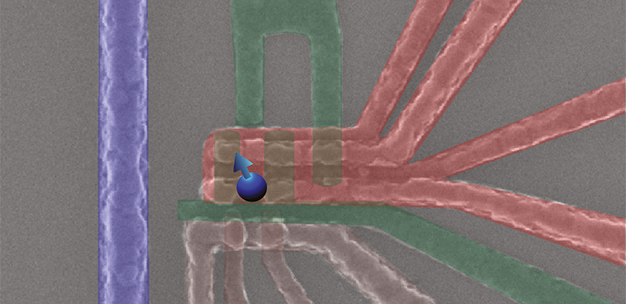An electronic circuit made from isotope-engineered silicon creates a better basic unit for a quantum computer
Published online 6 March 2015

Electrical contacts (red) trap a single electron that is monitored by a nearby transistor (gray). The properties of this quantum-dot qubit are tuned using the magnetic field around a transmission line (blue).
Reproduced, with permission, from Ref. 1 © 2014 M. Veldhorst et al.
A fundamental element of a quantum computer that is scalable and retains its state for much longer than comparable approaches has been demonstrated by an international team of researchers1.
Quantum computers promise to solve problems far beyond the capabilities of modern machines. Whereas conventional computers store and process information as a sequence of electrical pulses, the quantum equivalent uses a physical system that is small enough to exhibit its quantum properties.
These quantum equivalents of classical bits, known as qubits, can come in many forms, and each has its own advantages and disadvantages. One approach is to use atomic impurities in otherwise perfect crystal structures, while quantum dots are another type of qubit. Quantum dots are larger than atomic impurities and are hence easier to connect to electrical contacts for inserting and extracting data. Atomic impurities, on the other hand, can maintain their quantum properties for much longer.
Kohei Itoh from Keio University, Japan, and colleagues from Australia and the Netherlands have now created a qubit that offers the advantages of both approaches.
The team made their qubit from a thin film of silicon. Crucial to their success was the high purity of their material. In addition to the common silicon-28 atoms, standard silicon often includes atoms of the isotope silicon-29. The samples at Keio University were carefully created to reduce the number of these heavier atoms. "Our work shows that isotope engineering of silicon has a crucial role to play for quantum information applications," says Itoh. He and his co-workers fabricated quantum dots by laying down electrical contacts. The electrical field between the contacts trapped an electron in an area approximately 30 nanometers in diameter (see image). A nearby transistor monitored the quantum state of this electron and the magnetic field created by a microwave transmission line controlled the properties of the quantum dot.
The researchers tested the operation of the qubit by applying a sequence of pulses that created a device known as a Clifford gate. They measured a control accuracy, or fidelity, of 99.59 per cent. The quantum properties of their dot could remain stable for 28 milliseconds ― an order of magnitude longer than other types of semiconductor-based qubits.
"Moving on to two and more qubits is the next step," says Itoh. "We also intend to develop materials that will allow qubits to be buried under the surface and thus reduce the negative influence of interface defects."
Reference
- Veldhorst, M. et al. An addressable quantum dot qubit with fault-tolerant control-fidelity. Nature Nanotechnology 9, 981-985 (2014). | article